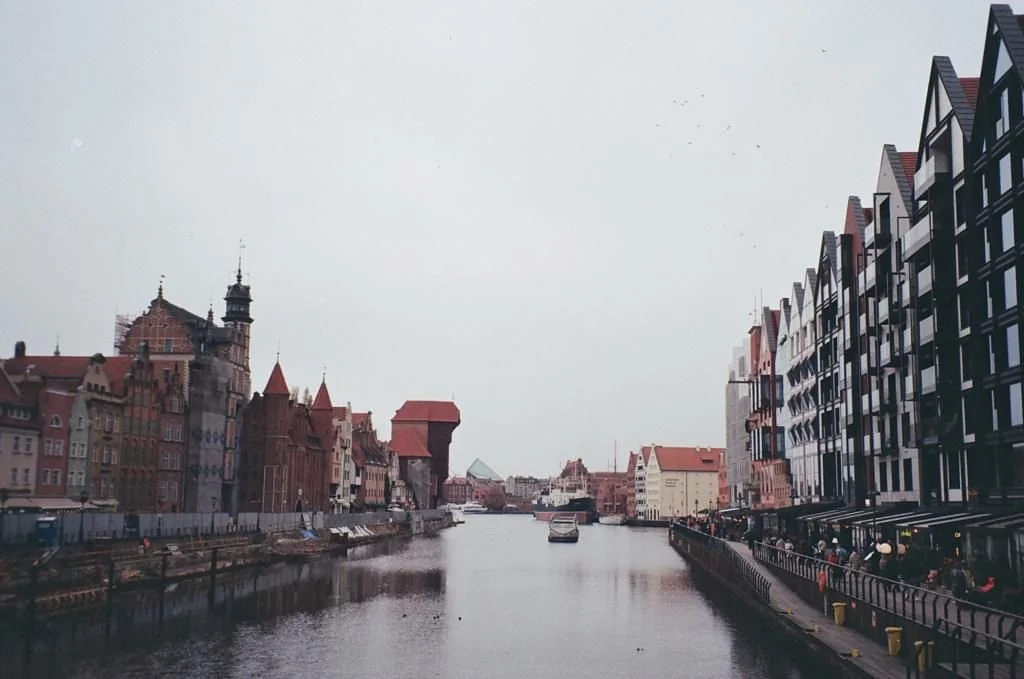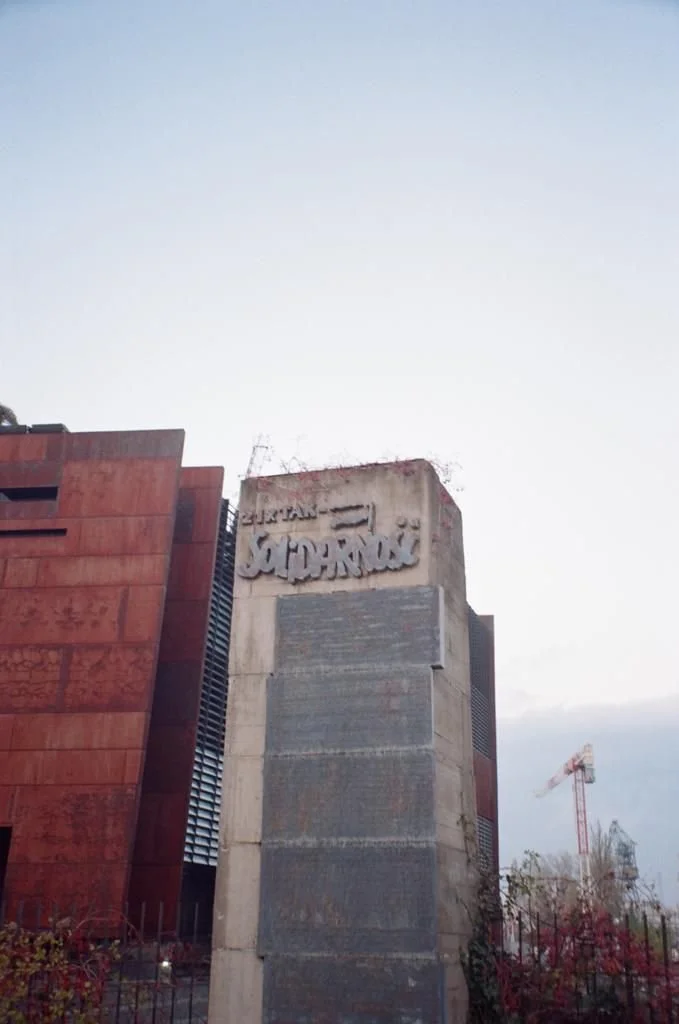72 Hours in Gdańsk
A photo taken from Zielony Bridge over looking the Motlawa river and the old town.
Day 1: Unveiling Gdańsk's Complex History
Morning:
Free Walking Tour of Gdańsk Old Town
Begin with a deep dive into the Old Town's fascinating history. Despite its charming medieval look, the entire Old Town was rebuilt after WWII—everything you see is a reconstruction, meticulously rebuilt to preserve Gdańsk’s former glory. The tour will walk you through the hidden stories behind iconic sites like St. Mary's Church and the Long Market. Learn how this city has been a crossroads for trade, conflict, and culture for centuries, with layers of history from Teutonic Knights to Hanseatic merchants.
Lunch:
Bar Mleczny (Milk Bar)
Step into an authentic communist-era experience at this no-frills canteen. These government-subsidised “milk bars” were once vital to feeding the Polish population during socialist times. Here you’ll try classic Polish dishes like pierogi, żurek (sour rye soup), and placki ziemniaczane (potato pancakes). The atmosphere is nostalgic, and the prices are incredibly budget-friendly.
Afternoon:
European Solidarity Centre
This museum is dedicated to the Solidarity movement, which began in the Gdańsk shipyards and eventually led to the fall of communism in Poland. The exhibitions are immersive and emotional, detailing the courageous efforts of workers, including the iconic Lech Wałęsa, who fought for freedom. Take your time to explore the powerful stories of resistance, many of which are lesser-known but vital to Europe's political landscape today.
Evening:
Józef K Bar
Named after Kafka’s famous character, Józef K is a hidden gem with a dark, moody interior, perfect for unwinding. The bar is known for its experimental cocktails and offbeat atmosphere. You might even encounter a surprise live jazz performance! This place attracts a crowd of creatives and students, so it’s perfect for meeting like-minded people.
Day 2: WWII Memories and Seaside Views
Morning:
Museum of the Second World War
Dive deep into the global and personal tragedies of WWII at this expansive museum. Gdańsk holds special significance as the place where the first shots of the war were fired at Westerplatte. Exhibitions cover not only military history but also the everyday lives of those who endured the conflict. A lesser-known fact: The museum is designed to convey the weight of history, with its heavy, sinking architectural style reflecting the sense of inevitable destruction that war brings.
Lunch:
Swojski Smak
After a morning of heavy history, head to Swojski Smak for a hearty Polish lunch. This restaurant offers traditional, home-style Polish dishes, with specialties like schabowy (breaded pork cutlet) and bigos (hunter’s stew). Swojski Smak prides itself on authentic flavors, slow-cooked to perfection, just like Polish grandmothers used to make. The restaurant also hosts a variety of locally brewed polish beer and liquor.
Afternoon:
Westerplatte Peninsula
This symbolic site marks the location where WWII began. Walk along the ruins of military bunkers and visit the monument dedicated to Polish soldiers. It’s an eerie yet peaceful place, offering views of the Baltic Sea, and a reminder of the strength of resistance against Nazi invaders.
Evening:
Pan Kotowski
Finish the day at this cozy Ukrainian-Polish restaurant, a beloved local spot where cultures meet on a plate. Their dumplings—both Polish pierogi and Ukrainian vareniki—are crowd favorites, but don’t miss the borscht or the chebureki (deep-fried pastries with minced meat). It’s a true gem in Gdańsk’s evolving food scene, and showcases the variety of culinary influences on Poland.
Day 3: Coffee Culture and Creative Spots
Morning:
Kaffe Perro Negro
Start your day at this trendy café known for its minimalist design and exceptional coffee. Their specialty brews come from ethically sourced beans, and the vibe is relaxed but hip, attracting locals and digital nomads alike. Try their famous flat white or pour-over coffee and pair it with a freshly baked pastry.Ciekawa Café
If you’re a café-hopper, head next to Ciekawa Café, a laid-back spot with vintage décor and a quiet ambiance. They serve great artisanal coffee, and their homemade cakes are a must-try, especially the sernik (Polish cheesecake). This café is also a gathering place for artists and writers, so keep an eye out for impromptu creative sessions.
Lunch:
Tygle Gdańsk
This charming little bistro offers a fresh twist on Polish cuisine. Located just outside the main tourist areas, it’s known for its seasonal ingredients and small, curated menu. The dishes are creative yet grounded in Polish tradition—think beetroot carpaccio or pumpkin soup with a Polish twist.
Afternoon:
Kawiarnia Retro
Take a coffee break at Kawiarnia Retro, a quaint café with an old-timey feel. The nostalgic décor—old radios, typewriters, and sepia-toned photographs—takes you back to the mid-20th century. This place specialises in hand-dripped coffee and homemade sweets, such as kremówka (Polish cream cake), perfect for an afternoon treat. Their hot chocolate is an absolute must try!
Evening:
Józef K Bar (Second Visit)
If you missed it the first night or simply want to revisit, spend your last evening in Gdańsk at Józef K. The relaxed, intellectual vibe here makes it the perfect spot for reflecting on your trip, swapping stories, or even catching some underground live music. Be sure to try their signature cocktail inspired by Kafka’s works.Fun facts:
A Crossroads of Cultures
Gdańsk has always been a meeting point for different cultures—German, Polish, and Dutch influences blend in its architecture and heritage. Few people realize that Gdańsk’s Old Town is a UNESCO site despite being a “fake” reconstruction. The city's multicultural history is reflected in everything, from the food to the language, giving it a uniquely complex identity.The Amber Connection
Gdańsk is famous for its amber, often called the "Baltic gold." The city was historically one of the most important amber-trading centers, with the Amber Route running right through it. To this day, you can find beautiful amber jewelry in markets and shops across the city, a legacy that goes back thousands of years.The Iconic Rainspouts
The historic drains on Gdańsk’s Old Town buildings, often shaped like gargoyles or fantastical creatures, were both functional and decorative. They channeled rainwater away from building facades, preventing damage, while also serving as symbolic figures that reflected the wealth or identity of the owners. Extending from steep roofs into narrow streets, these elaborate spouts, inspired by Gothic architecture, added charm and drama to the medieval cityscape. Many were faithfully recreated during Gdańsk’s post-WWII reconstruction to preserve the city's unique character.
The Free City of Danzig
Gdańsk was not always a part of Poland. From 1920 to 1939, it was the Free City of Danzig, an autonomous city-state under the protection of the League of Nations. It was a cosmopolitan hub with a diverse population of Poles, Germans, and Jews, living under a somewhat uneasy peace. This unique status came to an end when Nazi Germany annexed it in 1939, sparking the outbreak of WWII.
This 3-day journey through Gdańsk will offer a rich blend of history, culture, and local flavor, with plenty of opportunities to explore hidden histories and creative spaces. Enjoy every moment in this beautiful, reconstructed gem of Poland!
A photo of the Solidarity monument at the old shipyard, the birth place of the Solidarity movement.

